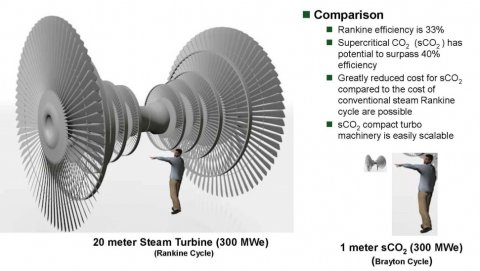
The purpose of the Supercritical Carbon Dioxide (sCO2) Technology Team is to use a collaborative approach to develop and facilitate commercialization of sCO2 energy conversion technology.
Within the Department of Energy (DOE), SCO2 Brayton Cycle energy conversion could benefit research and development efforts in the offices of Nuclear Energy, Fossil Energy and Energy Efficiency and Renewable Energy. The Tech Team members draw from each of these programs and work together to achieve the highest efficiencies offered by the sCO2 Brayton Cycle technology (compared to the widely-used steam turbine Rankin Cycle.)
Benefits of the sCO2 Brayton Cycle for energy production Economic and environmental benefits of the technology include:
- Broad applicability to variety of heat sources
- Higher plant efficiency
- Reduced fuel consumption and emissions
- Low cooling water consumption
- Compact design/footprint lowers capital cost
Public policy benefits include:
- U.S. leadership in a transformative technology
- Enhanced U.S. global competitiveness
- Progress towards DOE Strategic Goals and President’s Climate Action Plan
Supercritical carbon dioxide is a fluid state of carbon dioxide where it is held at or above its critical temperature and critical pressure. Carbon dioxide usually behaves as a gas in air at standard temperature and pressure (STP), or as a solid called dry ice when frozen. If the temperature and pressure are both increased from STP to be at or above the critical point for carbon dioxide, it can adopt properties midway between a gas and a liquid. At this state, sCO2 can be used efficiently throughout the entire Brayton cycle.
A Brief History: Closed Brayton cycles for power generation have a commercial history dating to the late 1930’s when the first of a series of power generation plants using the closed Brayton cycle made use of air as a working fluid. These closed air Brayton units operated from the late 1930’s through the 1970’s using a variety of energy sources including coal, gas, and waste heat. These recuperated Brayton cycle installations achieved good reliability and relatively high efficiencies as compared to other power generation technologies of the era. Other mediums were used as well.
Recompression Closed Brayton Cycle Schematic Diagram
Closed Brayton cycles using supercritical CO2 are actively being pursued as a high efficiency cycle for the next generation of power blocks by a diverse set of technology areas including nuclear power generation, fossil fuel power generation, concentrated solar power, shipboard power, waste heat recovery, and geothermal power generation.
<p>The Supercritical Carbon Dioxide Tech Team<br><a href="mailto:SupercriticalCO2@hq.doe.gov">SupercriticalCO2@hq.doe.gov</a><br>…. Department of Energy<br>1000 Independence Ave, SW<br>Washington, DC 20585</p>




